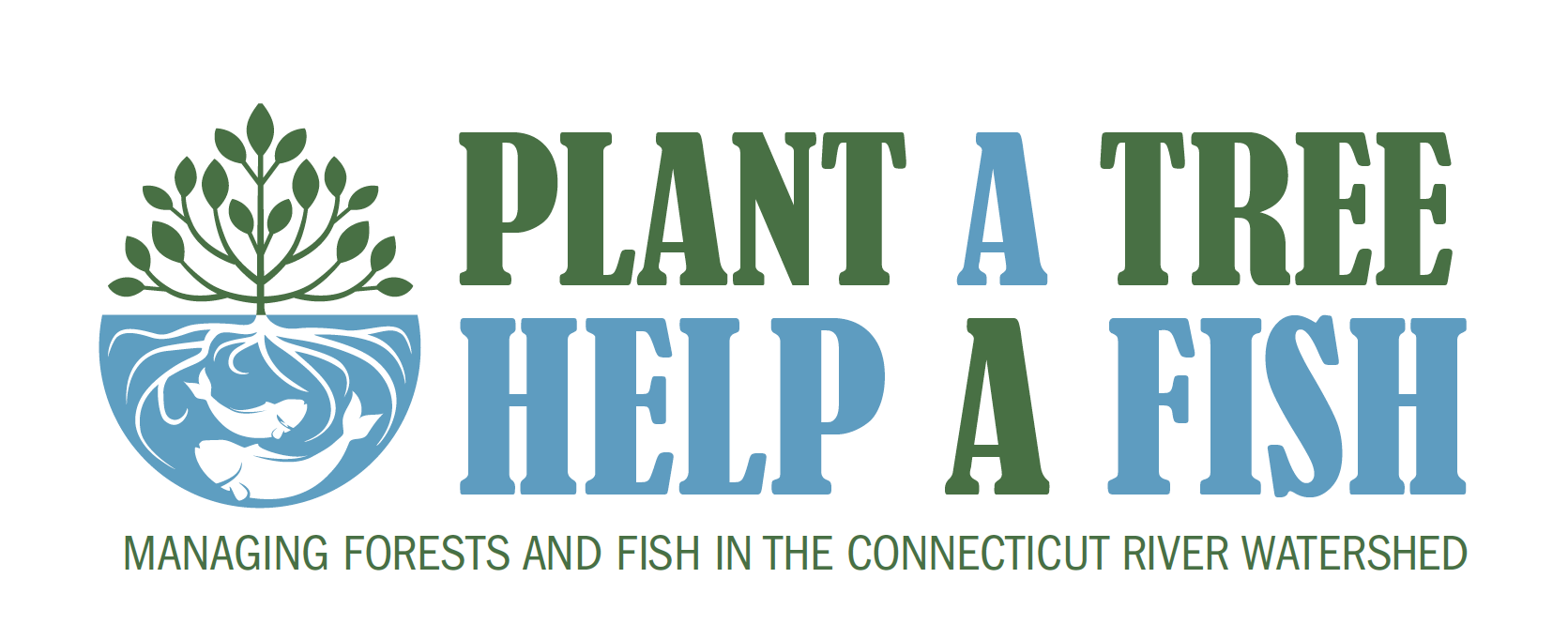
The Connecticut River isn’t merely New England’s longest river. It is also an American Heritage River, a designation bestowed by President Clinton in 1998, and shared by the Hudson, the Potomac, the Rio Grande, and 10 others. Fish restoration in the river depends, to a significant extent, upon its forests and the management thereof.
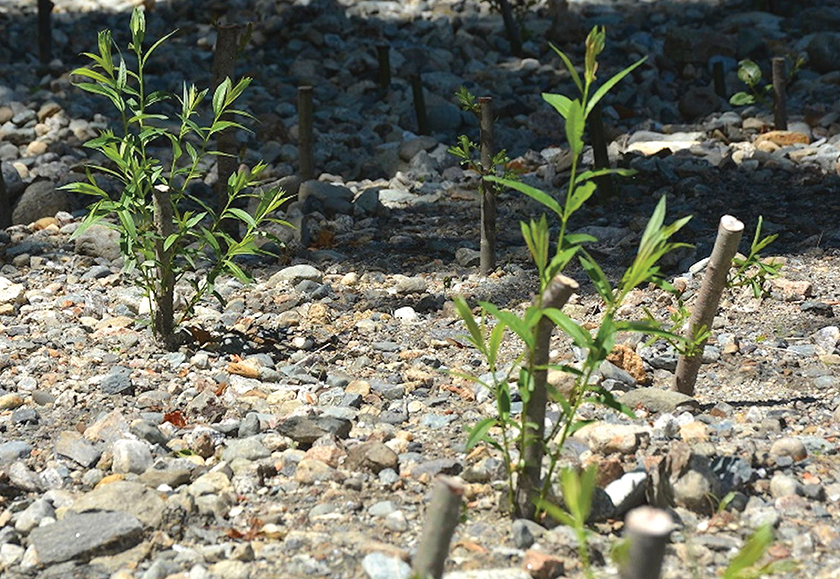
Recently planted shrub willow and red osier dogwood live stakes will stabilize the stream bank.
Courtesy of Connecticut River Conservancy
A 2006 report by the Trust for Public Land described the watershed’s forests:
The Connecticut River watershed is nearly 80 percent forested, an extraordinary number considering that it may have been as much as 80 percent cleared in the mid-19th century. Nearly one third of the forestland is within roadless blocks of more than 1,000 acres that permit economically efficient forestry operations. The watershed contains high-quality timberland and is stocked with nearly twice as much timber volume per acre as the average New England forest. More than 31 percent of all forestland in the watershed is protected from development. But despite tremendous conservation victories that ensure sustainable harvests and jobs, the watershed’s forests remain threatened. The US Forest Service’s “Forests on the Edge” study ranked portions of the watershed among the top 20 areas in the nation with high development threat and high rates of private forest ownership.
In recent years, restoring fish habitat in the watershed has become a priority for several state and federal agencies, conservation organizations, and landowners. Since 2014, the US Natural Resources Conservation Service has provided more than $11.4 million in financial and technical assistance to the four states in the watershed via the Regional Conservation Partnership Program (RCPP).
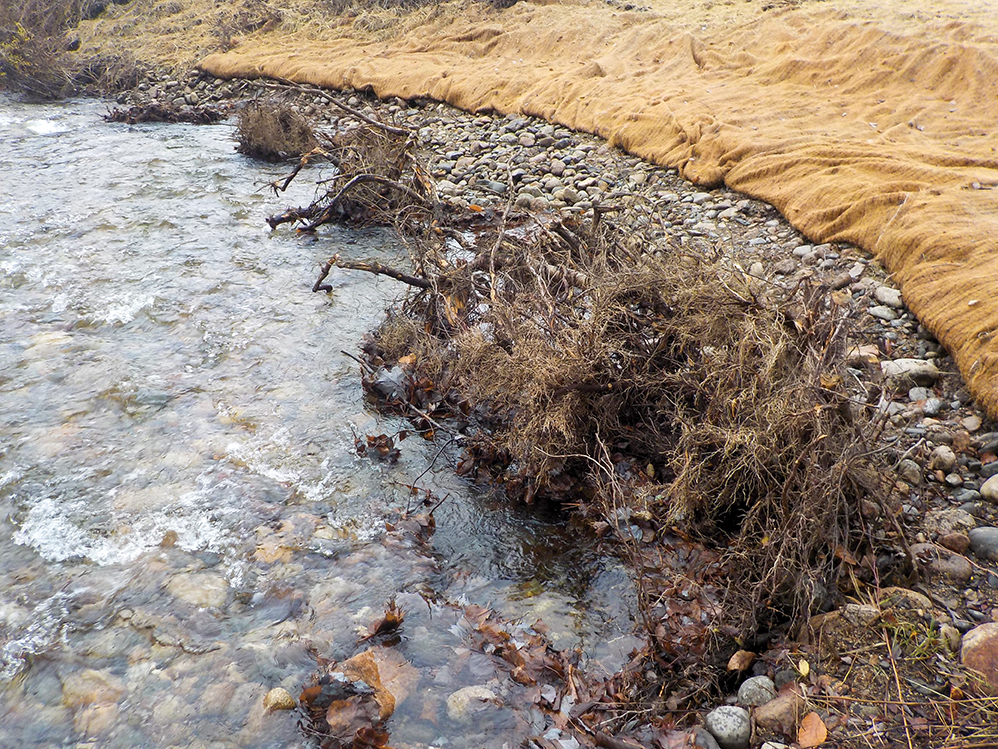
Exposed root wads and a natural fiber based, biodegradable erosion-control matting are all that remain after the completion of a project to repair erosion damage, create habitat, and protect recreational trails on Bissell Brook in North Stratford, NH. The root wads help absorb energy of the river during high flow periods. The matting prevents erosion and gives time for native species planted there to establish themselves.
Photo courtesy of Ron Rhodes, Connecticut River Conservancy.
“The program shows the value of best management practices in preventing non-point source pollution [other than sewers, for example] into the Connecticut River, thus improving water quality in Long Island Sound, a congressionally designated Estuary of National Significance,” said Connecticut state forester Christopher R. Martin. “RCPP’s value also has demonstrated that forestry as a land use choice is the most beneficial for water quality protection.”
To get a broad view of this work, I spoke with four people directly involved with the restoration efforts.
The Fisheries Expert
When I asked John Magee, fisheries habitat research and management programs coordinator for the New Hampshire Fish and Game Department, about the fish habitat restoration work his agency is doing, he led off by highlighting the importance of partnerships.
“Partnerships are huge for us because, frankly, we can do really good work on our own, but I think we do excellent work when we work with our partners,” Magee said. “Those partners range from individual landowners who might own a couple of hundred acres and are interested in improving fish habitat on their property, to nonprofits such as Trout Unlimited, The Nature Conservancy, and some local groups. And we work with other state agencies, such as the Department of Natural and Cultural Resources and the Department of Environmental Services. We also work with federal partners, primarily the Natural Resources Conservation Service, the Forest Service, and the Fish and Wildlife Service.”
Because the Connecticut River marks the border between New Hampshire and Vermont, Magee often collaborates with his counterparts in the Vermont Fish and Wildlife Department.
“The Connecticut River is a neat river, at least in terms of fish habitat, because the river itself and its headwaters, as well as most tributaries, are relatively cold to cool. The fish are generally trout and other species that need cool or cold water. The ones people fish for are generally trout. As it flows downstream, just like any river, it generally gets warmer and warmer, so by the time it leaves New Hampshire and Vermont and goes down into Massachusetts and then later into Connecticut, it’s much more of a warm-water species composition—largemouth and smallmouth bass, sunfish, walleye, and others.”
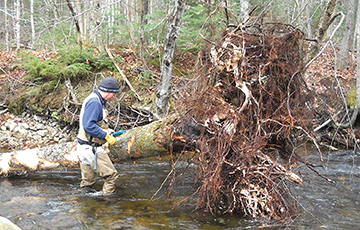
A blue tag on this tree, placed in the stream to help improve fish habitat, will identify it as it moves downstream over time.
Photo courtesy of Jim MacCartney, River Solutions LLC.
For Magee and his colleagues, restoring natural processes is a primary objective. As in streams across North America, large woody debris is crucial to healthy fish habitat. In addition to retaining sediment, large pieces of wood diversify fish habitat.
“Along with sediment being retained upstream, which provides some shallower habitat for aquatic insects and even little trout and other fish species such as sculpin, you have deeper areas, and of course, that’s where the bigger trout are going to be hanging out and growing,” Magee said. “Once you restore a stream with wood, a very typical response in the trout population is that it doubles, and this doubling is very quick—a year to three years,” he said. “Not only were there more trout, once we restored the wood to the stream, but the adult trout lived longer and got bigger.”
The Consulting Forester
Ben Machin is a partner and forester at Redstart Inc., a consulting firm based in Corinth, Vermont. The company manages about 175,000 acres of forest in Vermont and New Hampshire, primarily on behalf of private, nonindustrial landowners, as well as conservation organizations and public agencies. Redstart is doing more restoration work than in the past to improve fish habitat and water quality. The company works with partners, such as the Vermont Department of Fish and Wildlife, the US Natural Resources Conservation Service, the Connecticut River Conservancy, Trout Unlimited, The Conservation Fund, and The Nature Conservancy, to help restore rivers and riparian zones [riverbanks] in the Connecticut River watershed.
“Our partners and clients are looking at areas along streams that need to be revegetated. In some cases, we know the landowners already, and we’re helping to develop such projects from the very beginning. In other cases, we’re being asked to come in at the last minute and plant trees and shrubs. So, sometimes we determine the right species mix, [sometimes we] perform the on-the-ground work of getting the trees planted, and sometimes we do both,” Machin said.
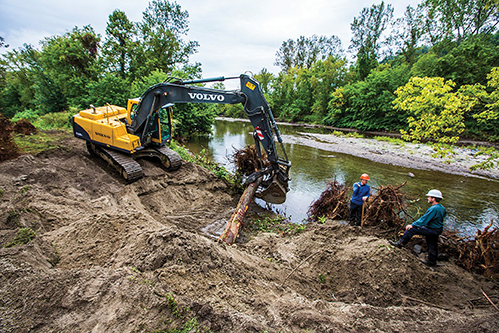
Downed trees are placed with their root wads protruding into the Waits River in Bradford, VT. The boles are buried in the bank to keep them in place.
Photo courtesy of Ron Rhodes, Connecticut River Conservancy.
“Strategic wood additions”—adding large woody material to streams—is a key part of many of the company’s restoration projects. “Habitat is a major goal of those projects, but the practice also makes important contributions to water quality, flood resiliency, and climate-change preparedness,” Machin said. “We use directional felling techniques to put trees into the water, many of which wouldn’t otherwise end up there on their own. And we leave a lot of the trees that will naturally fall in, so we’re accelerating a natural process, but we’re also increasing the total amount of wood that will end up in the stream over time.”
“Large trees with root wads that are trucked into the site are usually anchored to the bank—the root wad is exposed to the river, and a portion of the bole is on the bank,” said Machin. “It’s a more ecologically minded option than riprap [loose stones placed along a riverbank], but it has some of the same effects in terms of protecting the riverbank and downstream infrastructure.”
Riprap can help protect a streambank but often lets water accelerate, causing damage downstream. Root wads slow floodwaters and provide a refuge for fish.
“It’s personally rewarding to me to see so much restoration work in and along waterways,” he said. “If you had asked me 10 or 20 years ago, I would not have bet that there would be as much cultural willpower and as much alignment between different partners to get this work done.”
The Watershed Forester
Dave Wilcox is a watershed forester with the Vermont Department of Forests, Parks, and Recreation. What’s a watershed forester?
“My role is primarily to work with our water-quality rules—we call them acceptable management properties, or AMPs.”
Water quality and fish habitat quality go hand in hand. The AMPs address stream buffer width to minimize erosion from skid trails, roads, landings, and stream crossings. Wilcox and his colleagues focus much of their attention on the latter: bridges, culverts, or pole fords for truck roads and skid trails.
“We try to move from culverts to bridges for crossings of our perennial streams, and a perennial stream usually has fish, unless there is a barrier to fish, such as a poorly placed culvert or dam. Any new culverts have to allow “aquatic organism passage”—they have to be fish friendly. This makes a huge difference because that provides access to spawning grounds.”
Although culverts can be effective when they are sized and placed properly, the Vermont Department of Forests, Parks, and Recreation emphasizes the use of temporary bridges rather than culverts or pole fords. In the past, temporary pole fords were made by laying logs in a streambed to provide a platform for a skidder and its load, or a temporary culvert was installed. Even when loggers are careful, these practices can degrade water quality.
“Harvesting occurs over a year or two, and the loggers won’t be back for 20 years or more,” said Magee. “Why have a culvert or even a [permanent] bridge there if there’s no need for access?
The Vermont Department of Forests, Parks, and Recreation recently received a grant from the US Fish and Wildlife Service to purchase two heavy-duty temporary bridges that can be folded and transported by truck and placed with one or two excavators.
“You place concrete blocks on either side of the stream and do a little work to build an approach to the bridge, and once that bridge is set in place, you can drive a loaded log truck across it.…We have a program where we rent bridges to loggers, private foresters, landowners, and others, and we only charge $100….We have a 40-foot bridge and a 30-foot bridge, and they are unbelievably rugged.”
“Keeping forests as forests is the best answer to providing high water quality,” said Wilcox. “Sustainable management and following the AMPs are what really protect water quality and provide all the other benefits of a healthy forest economy—which Vermont relies on for many things.”
The River Steward
When I spoke with Ron Rhodes, a river steward with the Connecticut River Conservancy, a Greenfield, Massachusetts-based nonprofit, he had just returned to his office from a tree-planting project. The organization has planted more than 6,000 trees in 2020 at 11 sites. Species include maples, cottonwood, box elder, willows, and other species “that like to be along the river and have their feet wet.”
“We generally plant on two types of sites,” said Rhodes. “Last year, we did three dam removal sites. And we work with a lot of farmers and other private landowners who have erosion issues. We’re doing a lot of work with [the US Natural Resources Conservation Service] and the US Fish and Wildlife Service. Sometimes it’s an old cornfield or a hayfield, and the farmer is losing five or 10 feet [of the field] every spring. In many situations, we can come in with 400 stems per acre and get some live stakes to stabilize that area. They lose that buffer for their corn or haying, but hopefully over time, the buffer grows up and they don’t lose more soil.”
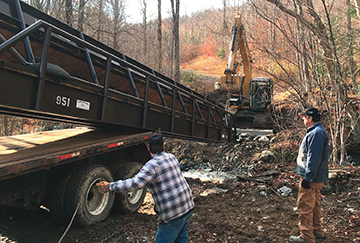
The Vermont Department of Forests, Parks, and Recreation rents folding temporary truck bridges to loggers, landowners, and others for $100 per month. It also rents temporary skidder bridges.
Photo courtesy of Vermont DFPR.
Restoration projects are the main focus for river stewards like Rhodes. The Conservancy has a river steward in each of the four states in the watershed; Rhodes works mostly in Vermont.
“We each have very unique jobs,” he said. “Obviously, the watershed is very different in Connecticut than it is here in the upper reaches. We have a lot more farms and different issues than they have in Springfield, Massachusetts, or Hartford, Connecticut. We don’t have any cities like that up here.”
The condition of fish habitat in Vermont and New Hampshire is good, overall, Rhodes said, with generally healthy populations of brook trout.
“Back in the day before dams were built, we had salmon coming from the ocean all the way up into Vermont and New Hampshire. That obviously doesn’t happen anymore,” he said. “Brook trout may not have been in the Connecticut main stem, but [they] were in the larger tributaries. Now, with development, roads, and so on, those rivers have warmed up, and the brook trout are pretty much confined to small feeder streams at higher elevations where there are some deep spots in the main stem [i.e., the Connecticut River] that are cold enough for travel to survive. In the main stem, where the waters are warmer, you’ll find bass and pike and other warm-water species.”
Adding large woody material to upland streams is a priority for the Connecticut River Conservancy, US Natural Resource Conservation Service, Trout Unlimited, and other partners. These agencies and organizations often work with landowners who have forested parcels. Rhodes himself owns about 100 acres in Vermont and works with a consulting forester to manage his property.
“In the next several years, adding wood to streams is going to be a real focus. First of all, it’s relatively easy to do—it’s a heck of a lot easier and cheaper than a dam removal project. There’s a lot less equipment involved—you’re doing this by hand with chainsaws and winches.”
Beyond the pandemic, climate change is a longer-term concern.
“The good news is that our restoration work—tree planting, buffers along the river, wood in streams, and dam removals—improves fish habitat and helps keep streams cool, and that will help fish be more resilient in a changing climate.”
Regardless of the amount of funding, maintaining strong partnerships will be crucial to future fish habitat restoration.
“I take any opportunity I have to say this, but all of our work is based on partnerships,” said Rhodes. “We need private landowners to be willing to do these projects. We need companies like Redstart to help us implement projects. We need state and federal government agencies to provide expertise and help us figure out which projects are worth doing. We need partners who can provide funding. No one organization can do this work by itself—none of it would happen without partnerships.”
Steve Wilent is the editor of The Forestry Source, published monthly by the Society of American Foresters. He can be contacted by email at wilents@safnet.org. This is an edited version from the full-length version that appeared in The Forestry Source, June 2020 issue, © The Society of American Foresters. Reprinted here with permission.

